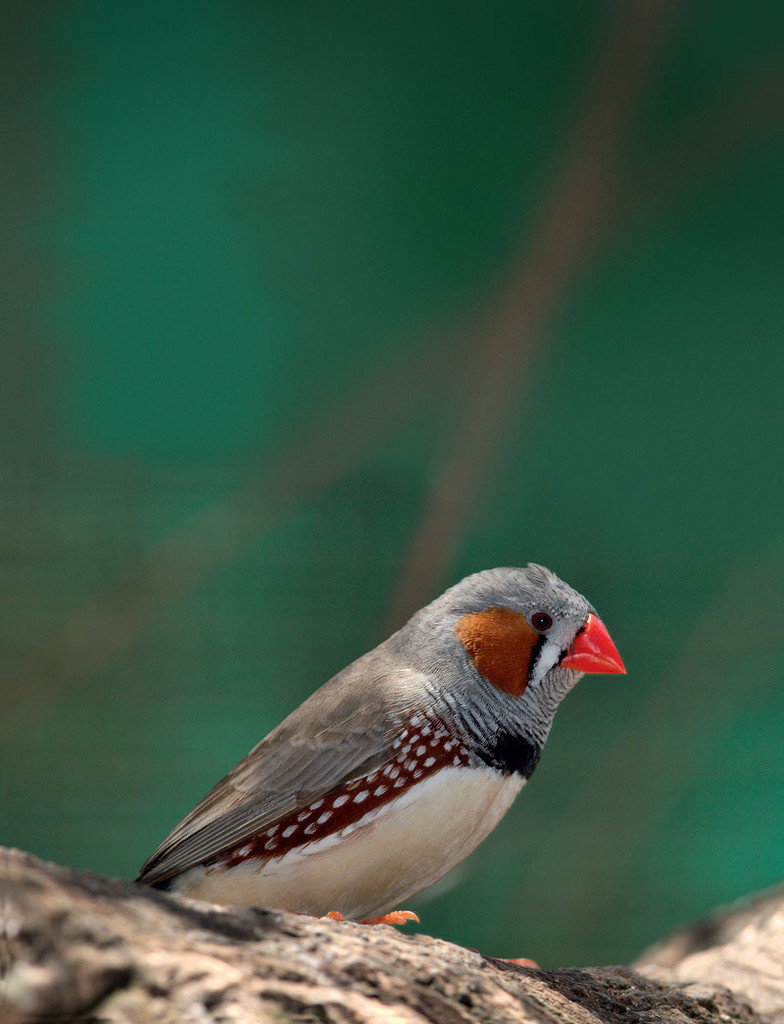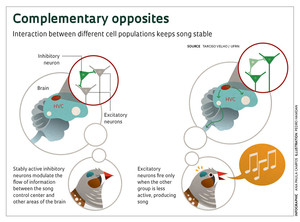
Tarciso Velho / UFRN
Zebra Finch: frequently used in behavioral experimentsTarciso Velho / UFRNAnyone who has heard the persistent song of the Rufous-bellied Thrush in the daytime or during the wee hours of a Spring morning in Brazilian cities must have noticed the endlessly repeated notes. One possible explanation for the repetitive aspects of that song has just arisen from research on the brain of the Zebra Finch (Taeniopygia guttata), another songbird species which is used frequently in behavioral experiments in the laboratory. One type of cell in the complex and adaptable network of neurons responsible for vocalizations in songbirds remains stable in the Zebra Finch, according to a paper published in Nature Neuroscience in October 2016.
“The repetitions in the song of the adults are practically identical to one another,” explains neuroscientist Tarciso Velho, a professor at the Brain Institute of the Federal University of Rio Grande do Norte (UFRN), who coauthored the study. “It is a feature that makes these animals an ideal model for studying the relationship between neural activity and behavior.” The group, headed by American physicist Timothy Gardner of Boston University, analyzed the activity of two groups of neurons in a specific area of the brain responsible for controlling song, known as the HVC. Inhibitory neurons show intense localized activity within the HVC. The current thinking is that when their activity decreases, other types of neural cells known as excitatory neurons move into action, activating a chain of neurons that controls the muscles linked to song production.
The mystery surrounding vocal stability arises from the plasticity of the cerebral nucleus that controls song. In the brain of a songbird, and in some areas of mammal brains, there is a constant process in which some cells die while new ones are generated. In addition, even in a stable cell population, the connections between them may be rearranged. These changes in neuronal connectivity are interpreted as the neural basis of learning, a process in which sound appears to play an important role. “When we recorded images during song, we observed that the activity of the excitatory neurons varied from one day to the next, with cells entering and leaving the group that was involved in song production, so that the neurons involved in neural activity were not always the same ones,” Velho explains. But the song remains stable despite this dynamic scenario. The secret appears to lie in the inhibitory cells: in the experiments conducted in Boston, there was little variation in the activity of these cells. This appears to be responsible for the stability of an attribute that is key to intra-species recognition, without which the females would have more difficulty finding their reproductive mates.
 Inside the head
Inside the head
These findings were possible thanks to tiny devices developed by Gardner. “When captured, a songbird will not sing,” Velho explains. “We need to let it loose in the cage, with devices that do not hinder its movement.” To meet this need, the researchers implanted electrodes in the brains of songbirds to monitor the inhibitory cells for several months. Even more impressive are miniature microscopes weighing less than two grams. Produced by a 3-D printer, these microscopes were implanted in the brains of songbirds, enabling the researchers to detect the fluorescence emitted by the activity of excitatory cells, through a protein inserted by means of a virus to act as a calcium sensor. Calcium is a key element in the electrical activity of neurons. “Both methods enabled us to make brain recordings in birds that were awake, and behaving and moving around freely,” Gardner says.
The American physicist believes the distinct behavior that these techniques detected in the two cell types is the basis of song stability. Although the activity of each excitatory neuron varies, any gaps are compensated by the activation of neighboring cells, which tend to fire simultaneously. “This redundancy suggests that, if a cell ceases to function, another can play a similar role and maintain the stability of the network, and hence the motor response,” he notes. The study also showed that the localized activity of the inhibitory cells modulates the operation of the network. “Individual neurons likely optimize their activity within a larger structure that remains immutable for years.”
Due to their unchanging and predictable behavior in the caged environment imposed by a life as a laboratory guinea pig, Zebra Finches are the favorite subjects of researchers focused on understanding vocal development—a stereotyped, repetitive learned behavior. Gardner maintains that they may also help shed light on some aspects of human speech. “Neural networks in mammal brains need to solve similar problems,” he says. “It would be interesting to investigate whether these motor programs are controlled and maintained in a similar manner.” They say that once you learn to ride a bicycle, you never forget. It remains to be seen if mechanisms involving inhibitory and excitatory neurons could be the basis of this type of long-term motor capacity.
Scientific article
LIBERTI III, W. A. et al. Unstable neurons underlie a stable learned behavior. Nature Neuroscience. Online. October 10, 2016

